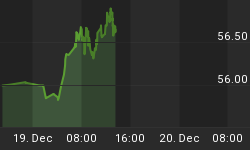Below is an extract from a commentary originally posted at www.speculative-investor.com on 8th February 2007.
Anyone who follows the gold and currency markets closely will realise that the US$ gold price and the Dollar Index generally trend in opposite directions; or, to put it another way, that the US$ gold price and the Swiss Franc generally trend in the same direction. This reciprocal relationship between gold and the dollar is often not evident on a daily or weekly basis, but is almost always evident during periods of 12 months or longer.
The reason that gold and the dollar generally trend in opposite directions is that in one respect gold is just another currency. It is no longer money in the true meaning of the word, but it tends to trade as if it were. As a result, when the dollar weakens on the foreign exchange market over an extended period then the US$ gold price will generally rise during the same period; and when the dollar strengthens over many months the US$ gold price will usually fall. There are, of course, leads and lags and there's no reason to expect that percentage changes in one will be accompanied by equal-and-opposite percentage changes in the other, but when charts of the dollar and gold are compared it quickly becomes apparent that the two have been inversely correlated since the floating -- some would say sinking -- currency system came into being in the early 1970s.
In discussing the dollar-gold relationship in the above paragraphs we used the words "generally", "usually" and "tend" because over the decades there have been a few periods when gold and the dollar have NOT trended in opposite directions. One such period occurred between May and November of 2005, prompting many gold bulls to proclaim that gold had de-coupled from the dollar. However, this proved to be just a 6-month aberration within a 10-year period during which the traditional relationship was very strong.
Another period during which the traditional inverse relationship broke down was May through to December of 1993. As illustrated by the following chart, gold and the Dollar Index had a strong positive correlation during the aforementioned period.

The most pronounced divergence of all from the traditional gold-dollar relationship occurred during 1978-1980 and is clearly evident on the following chart comparison of the US$ gold price and the Swiss Franc (the SF/US$ exchange rate). The chart shows that the best gold rally of the past 100 years -- a rally that took the gold price from $200/oz to $800/oz in the space of just 14 months -- occurred while the US$ traded sideways relative to the Swiss Franc. In this case, gold was not driven upward by weakness in the US$ relative to other paper currencies, but, instead, by fears that the world's monetary system was coming apart at the seams. There was a mass exodus from all paper currencies and one of the main beneficiaries was the substance that had invariably been chosen by the market to perform the role of money during those historical periods when it had been free to choose.

We suspect that gold's best gains during the current secular bull market will ultimately come in response to the same sorts of fears that led to the dramatic 1978-1980 price surge. In any case, the point we really wanted to make is that gold never actually de-couples from the currency market because the investment demand for gold -- the only thing that really matters as far as gold's intermediate- and long-term price trends are concerned -- is inexorably linked to what's happening to the official currencies. Most of the time gold responds to trends in the dollar's foreign exchange value, but there are also times when it responds to changes in the general level of confidence in paper money regardless of whether the US$ happens to be a relatively weak or a relatively strong currency.















